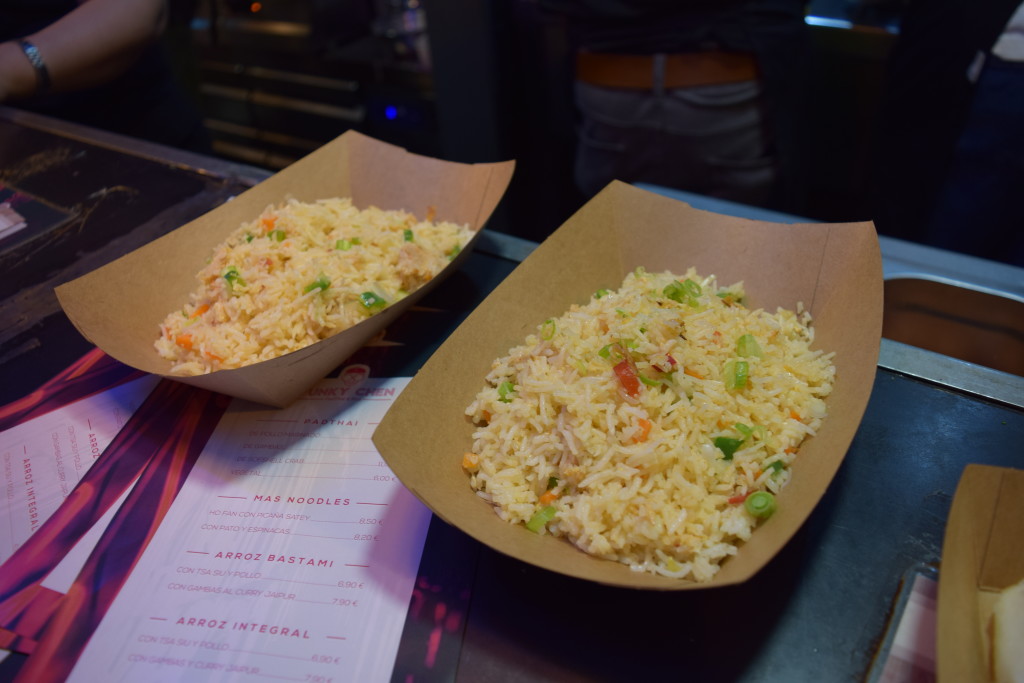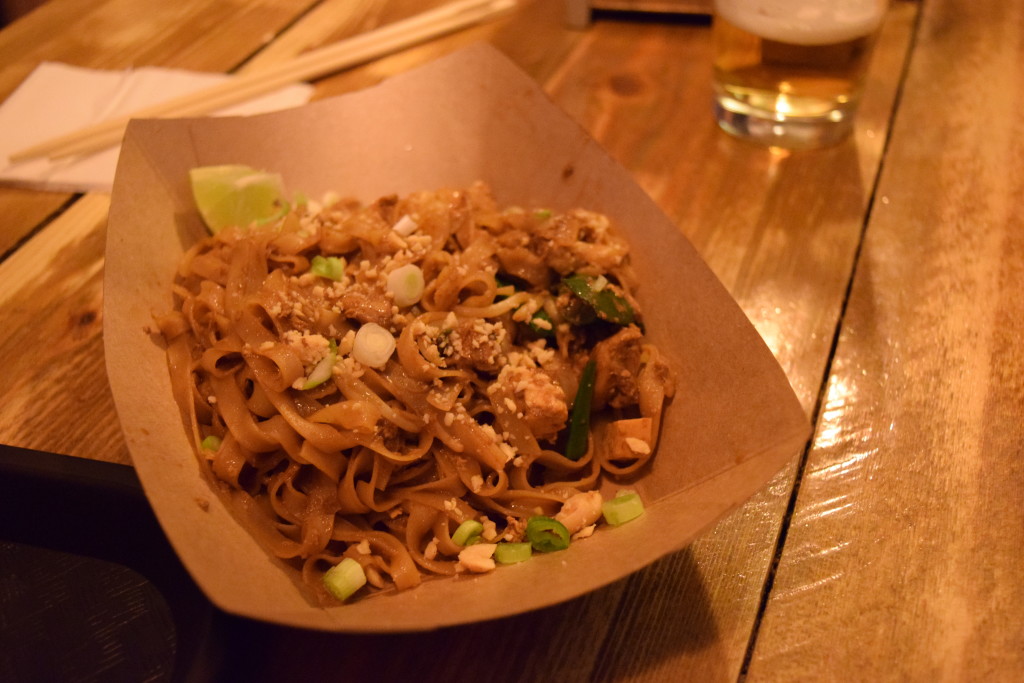When it comes to restaurant reviews, the word “authentic” gets thrown around a lot. It’s become a buzzword for people seeking out genuine food and unique eating experiences, but all too often it’s used as a catchall adjective that doesn’t really mean much, a vague and perhaps inaccurate way to lure in customers looking for “the real deal.”
This is not the case at Keyaan’s. If there were ever an establishment that deserved the label of authenticity, it would be this place. Specializing in Dominican empanadas, traditional sides, and homemade desserts, the colorful café brings a true taste of the D.R. to the streets of Chamberí. After opening its doors only two months ago, it’s already accumulated a loyal clientele—and it only takes one bite to understand why.

The story of Keyaan’s began with a simple craving. Around two years ago, just after her son Ilias was born, Zakiya Ramirez had a powerful longing for a good empanada. Her husband Aderly, who hails from the Dominican Republic, called up his mom and asked for her recipe. After a bit of tweaking and improvisation, he cooked up his very first batch of empanadas using nothing but a hot plate. Zakiya was floored; it seemed her husband had a hidden natural talent that not even he was aware of.

Zakiya, Aderly, and Ilias Keyaan Ramirez
In the years since, Aderly’s recipe gradually evolved and improved until the couple decided it was time to share his skills with the world. They opened Keyaan’s in November, christening it with their son’s middle name, and it’s already gained a considerable—and well-deserved—reputation.
I recently dropped by to sample some of their signature offerings, with my friend and trusty taste-tester Sophia by my side. We were presented with dish after dish of Dominican delicacies, hitting as many of the menu’s high spots as possible before falling into a full-on food coma.

First up: the empanadas. Aderly’s specialty is front and center at Keyaan’s, making up the bulk of the menu. You can choose from several fillings (beef, chicken, cheese, vegetables, tuna, and even pepperoni, in a variety of combinations) and two sizes (just one of the big ones will fill you up, but the mini empanadas are too cute to resist). Unlike some versions, these are chock full of the good stuff, meaning you won’t be biting into a pocket of air. The dough is made fresh each day, and every single empanada is hand-formed and fried to order. The result is crispy on the outside, soft on the inside, and juicy without being greasy; a difficult balance to strike.

As tempting as it may be to gorge yourself on nothing but empanadas, it would be a crime to leave without sampling the sides. The fritos (flattened and fried plantains, similar to tostones) and bollitos de yuca (fried balls of yucca stuffed with melty gouda cheese) also achieve an ideal equilibrium, indulgent and rich without being too heavy.


Not to mention the quipes—fried balls of bulgur wheat dough stuffed with chicken, beef, or cheese—a classic dish that arrived in the Dominican Republic by way of the Arab world (you might have tried its Middle-Eastern cousin, kibbeh).

Upon biting into one, Sophia’s first words were “I just wanna dive into it.” In fact, she named it her favorite of all the dishes she tried, which is certainly saying something. According to Zakiya, it’s a customer favorite as well; almost every Dominican who comes to Keyaan’s orders empanadas with a side of quipes, and they’re far from disappointed. One regular swore that their empanadas are even better than those of the most famous restaurant in Santo Domingo. Needless to say, authentic is an understatement.

If you’ve managed to make it through the savory stuff without getting too full, you won’t be disappointed by dessert. There’s a wide selection of batidos in flavors ranging from the classics to irresistibly creative inventions. The fruitier options (strawberry, papaya, coconut, and mango) are made the Dominican way, with evaporated milk, while the richer varieties (chocolate, vanilla, Oreo, Kinder Bueno, Ferrero Rocher, galleta Biscoff, and magdalena) are made with ice cream for a more American-style milkshake. They’re served in enormous glasses and topped with whipped cream, ideal for sharing (or not). Not too sweet, perfectly rich, and deliciously creamy. You might be surprised at how fast you can finish one.

Galleta Biscoff batido: “Like drinking a cookie”
Still hungry? Try one of the sweet empanadas, dreamed up as a way to combine Aderly’s talents with Zakiya’s passion for baking. The same perfectly fried dough, stuffed with apple pie, dulce de leche, nutella cheesecake, Oreo, white chocolate, strawberries, or pineapple… it’s clearly a match made in heaven.
All of the desserts are made entirely from scratch, and rumor has it that Zakiya’s cheesecake is the best in all of Spain. If you want to taste it in all its glory, you can order it by the slice as well as in empanada form. For something a bit more traditional, try the majarete or habichuelas con dulce, classic Dominican desserts made from corn and beans, respectively.

White chocolate caramel cheesecake
To wash it all down, you can choose from a variety of espresso drinks made with Dominican Café Santo Domingo (“Even the coffee is amazing,” according to Sophia), including bulletproof coffee and affogato. Or give into temptation and go for Zakiya’s signature Nutella hot chocolate, or the Dominican specialty morir soñando (orange or passion fruit juice mixed with evaporated milk). If you want something a bit lighter, there are also several kinds of natural juices.

Keyaan’s offers weekly specials and events that draw a crowd of expats and locals alike. If you want to sample as many empanada flavors as possible, you’ll appreciate Lunes de Locura, when mini empanadas are available for just €1 each (and larger ones for €2.50). There are also monthly language exchanges, giveaways, and much more on the horizon. Zakiya has big dreams for Keyaan’s, hoping to one day turn it into an international chain with locations in London, Santo Domingo, and the United States. Her customers are already begging her to expand, so they can feed their newly formed empanada addictions no matter where in the world they may be.

For now, though, we’ll have to be satisfied with this cozy café and its incredible power to transport us from the center of Madrid to the middle of the Caribbean. Keyaan’s is unquestionably authentic, but it’s so much more than that: it’s a place where real homemade food takes center stage, giving us a taste not only of Dominican culture but also of the genuine tradition, dedication, and love that’s folded into each and every empanada. No wonder we keep coming back for more.

Professional taste-tester Sophia enjoying Keyaan’s specialties
Info
- Facebook & Instagram
- Address: Calle Blasco de Garay, 10
- Metro: Argüelles and San Bernardo
- Phone: 915 99 38 76










































